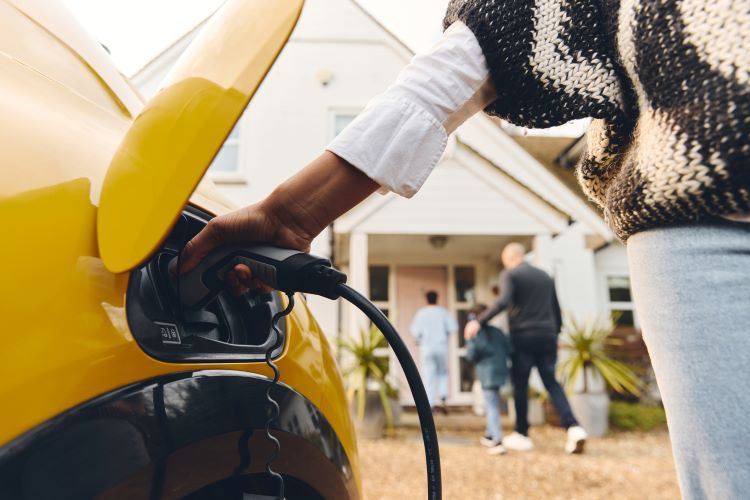Blog
Examining Electric Vehicle Hazards in Parking Garages
Renewable energies are the key to our sustainability and reduction of greenhouse gases. US automakers and legislators/regulators have been focused on moving from internal combustion engines (ICE) to electric vehicles (EVs) to lower greenhouse gases. Industry groups expect national EV sales to reach 4.75 million by 2030, up from 500,000 in 2020.

Automotive battery technology has developed rapidly to meet the demand for these renewable energy sources. Lithium-ion batteries (LiBs) have become the technology of choice thanks to their ability to provide a strong power source from a relatively small unit. As the batteries and their chargers become more common, so are the significant fire incidents attributed to their use.
The electrolyte used in LiBs is hydrocarbon-based and once alight, can lead to a chemical reaction known as thermal runaway. This is a very intense and rapidly growing exothermic reaction that can cause battery overpressure and explosion, as well as fires that can be hard to extinguish.
Traditional firefighting techniques may not be effective on LiB fires as they can often reignite once the extinguishing media is removed due to the ongoing chemical reaction. Cells can reignite hours or even days after they have been extinguished.
Garage owners and insurance carriers are increasingly concerned about fire losses. In this article, we address the exposures and risk mitigation controls associated with battery-operated vehicles within parking garages. We also provide steps garage owners can take to make their parking structures fire-safe.
Lithium-Ion Battery Failure: An Overview
The most common cause of a lithium-ion battery failure is a short circuit. This can occur when the micro-perforated separator (the barrier between the anode and cathode) is compromised in any way, such as a puncture, a dent, or crushing. Manufacturing defects may also result in battery failures. Once a failure occurs, the batteries become unstable, building pressure and heat, causing an exothermic chemical reaction and releasing the organic electrolyte. If it gets hot enough, the battery ignites. Studies from UL Research Institutes have shown battery cells can give off six liters of gases, build up to 4400 PSI, and heat up to 1200°F.
Early detection of a battery failure isn’t easy. The battery can emit gases and discharge a popping or hissing sound two to 30 minutes before failure, and although these early detection methods provide an indication of failure, the thermal runaway process has already occurred and cannot be reversed. It will likely spread to other cells.
Batteries can also fail when they are overcharged, over-discharged, or are charged incorrectly, such as when the temperature, voltage, or current are not within the specified ratings. All electric vehicle battery packs are equipped with a battery management system to prevent overcharging and over-discharging, thus minimizing this exposure.
Fire Challenges for Parking Structures
Fire engineers are investigating and testing the impact of an electric vehicle fire in parking structures. Today’s parking structures are designed to fit as many vehicles in a given space as possible. As vehicles become larger and wider, parking spaces have also become smaller and operators are using stacker systems. The result is that separation between vehicles becomes smaller, and fire spread between vehicles is more likely.
Other areas of concern that speed up a fire and increase heat release rates are:
- Plastics in vehicles, which make up more than 50% of today’s vehicles by volume
- Vehicles with fuel tanks (including plug-in hybrid vehicles) that can potentially burst or leak
- Low garage ceiling structures that lead to increased radiation and convection heating
Battery fires produce heavy smoke from burned fuel vapors containing metals and electrolyte particles, causing additional firefighting challenges and toxic hazards.
NFPA Provides Protection Strategies
Extinguishing a vehicle battery fire presents its own challenges. To control the thermal runaway event, firefighters must cool the battery. Current best practices focus on one of two methods: letting the fire burn out or extinguishing it with large amounts of water. Therefore, it’s critical to establish a reliable water supply from one or more fire hydrants and receive prompt fire department response.
The responding fire department should have established a policy or standard response guidelines to electric vehicle fires. The National Fire Protection Association (NFPA) has created an Electric Vehicle Emergency Field Guide for first responders (fire departments) and second responders (tow operators). The NFPA website has additional documents such as manufacturers’ emergency response guides and safety trainings for fire departments on incidents involving alternative fuel vehicles.
As modern vehicles evolve to use alternative fuels and higher amounts of plastics, new guidance from NFPA 88A, Standard for Parking Structures, now requires all parking garages to have sprinkler systems installed in accordance with NFPA 13. Prior to this new guidance, parking operators didn’t need to install sprinklers in open parking structures. Although the sprinkler system will not put out the car fire, it will reduce the rate of spread within the parking structure, therefore constantly quenching the car next to the one that’s on fire and stopping it from catching fire as well. According to NFPA, the 2022 edition of NFPA 13, Standard for the Installation of Sprinkler Systems, has changed to increase the recommended hazard classification for parking structures from an Ordinary Hazard Group 1 to an Ordinary Hazard Group 2. The effect is a 33% increase in water output from sprinklers. And similarly, as of January 2021, FM Global has changed the hazard classification for parking structures from HC-2 to HC-3, also increasing the sprinkler design density.
Electric Vehicle Parking Garage Risk Considerations: Hazard Chart
| Exposure | Lower Hazard | Higher Hazard |
|
Fuel (Current studies suggest that heat release rates are the same for electric vehicles and internal combustion engines.) |
|
|
| Vehicle condition | Older vehicles (<1990) with less plastic construction and curb weight. |
|
|
Charging: (EV charging stations and supporting equipment should be UL listed, following NFPA 70 guidelines Preventive maintenance should include annual thermal imaging.) |
Not charging | Charging: The fire is not related to the battery pack; rather, it’s caused by improper electrical insulation of the charging station, leading to a fire starting at the charging station and spreading to the car. Limiting charge lowers the fuel load. |
| Ignition source/location of battery | Truck, cabin, or hood: Accessible areas for suppressing a fire | Underneath the chassis of the car—not easily accessible. |
|
Re-ignition of battery |
The EV should be moved immediately, after the fire is extinguished to an outdoor place, away from combustible materials | Large battery packs, where multiple cells experience thermal runway without sufficient cooling. |
| Building structure | Concrete structure | Unprotected steel: Weakening at 1022°F that can lead to structural collapse |
Reduce Your Fire Risk
Although carriers are not restricting coverage for garages housing EVs, understanding the fire risks will allow you to take steps to reduce your exposure. Here are some best practices to consider:
- Early detection and quick response are critical. Work with your fire department and consider installing detectors.
- Make sure the first responding fire department has formal preplanning programs for EV fires in accordance with NFPA.
- Ensure the fire department conducts an annual walkthrough, locating the EV charging stations, hydrant connections, standpipe locations, and electrical disconnects.
- Consult with the fire department about designating employees to shut off power to EV charging stations.
- Explore installing thermal and off-gassing detectors in parking garages. Although these monitoring systems are still in development, results have primarily shown detectors to be effective in warning about incipient fires.
- All new parking garages are required to have automatic sprinklers and shall be designed per NFPA 13 2022 with OH2 0.2/1500 density.
- For existing parking garages, the authority having jurisdiction may require existing sprinkler protection around new charging stations or require electric vehicle parking to be reinforced to current NFPA standards. Consult a fire protection engineer to evaluate your existing sprinkler system.
- When installing EV charging equipment, follow NFPA 70, National Electric Code guidelines, and use UL-listed EV equipment.
- Conduct regular thermal imaging of electrical panels supporting charging equipment.
- Perform preventive maintenance on chargers.
- For Level 1 and 2 chargers, securely storing cables, keep equipment clean, and check for damage or wear.
- For Level 3 chargers, have a scheduled and corrective service maintenance plan that includes cooling systems, filters, and other components.
Woodruff Sawyer’s property engineers are available to help you understand your exposures and to consult on any electric vehicle projects.
Author
Table of Contents













